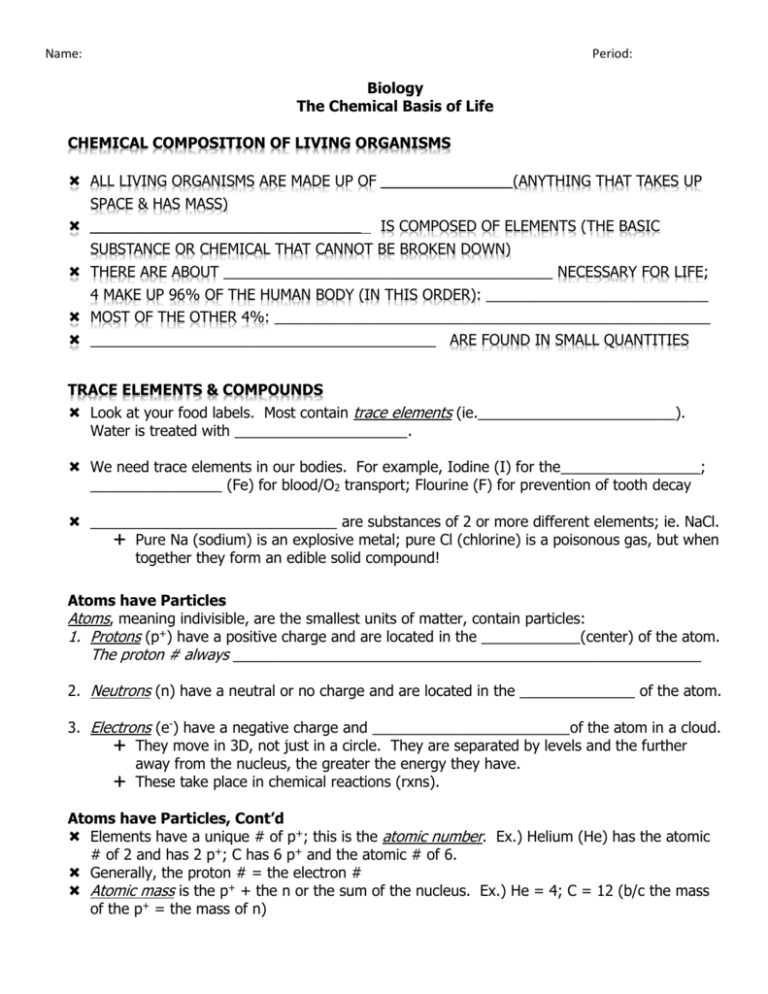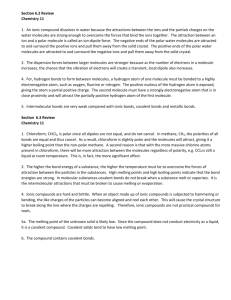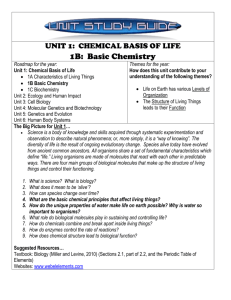Name: Period: Biology The Chemical Basis of Life chemical
advertisement

Name: Period: Biology The Chemical Basis of Life CHEMICAL COMPOSITION OF LIVING ORGANISMS ALL LIVING ORGANISMS ARE MADE UP OF ________________(ANYTHING THAT TAKES UP SPACE & HAS MASS) _________________________________ IS COMPOSED OF ELEMENTS (THE BASIC SUBSTANCE OR CHEMICAL THAT CANNOT BE BROKEN DOWN) THERE ARE ABOUT ________________________________________ NECESSARY FOR LIFE; 4 MAKE UP 96% OF THE HUMAN BODY (IN THIS ORDER): ___________________________ MOST OF THE OTHER 4%: _____________________________________________________ __________________________________________ ARE FOUND IN SMALL QUANTITIES TRACE ELEMENTS & COMPOUNDS Look at your food labels. Most contain trace elements (ie.________________________). Water is treated with _____________________. We need trace elements in our bodies. For example, Iodine (I) for the_________________; ________________ (Fe) for blood/O2 transport; Flourine (F) for prevention of tooth decay ______________________________ are substances of 2 or more different elements; ie. NaCl. Pure Na (sodium) is an explosive metal; pure Cl (chlorine) is a poisonous gas, but when together they form an edible solid compound! Atoms have Particles Atoms, meaning indivisible, are the smallest units of matter, contain particles: 1. Protons (p+) have a positive charge and are located in the ____________(center) of the atom. The proton # always _________________________________________________________ 2. Neutrons (n) have a neutral or no charge and are located in the ______________ of the atom. 3. Electrons (e-) have a negative charge and ________________________of the atom in a cloud. They move in 3D, not just in a circle. They are separated by levels and the further away from the nucleus, the greater the energy they have. These take place in chemical reactions (rxns). Atoms have Particles, Cont’d Elements have a unique # of p+; this is the atomic number. Ex.) Helium (He) has the atomic # of 2 and has 2 p+; C has 6 p+ and the atomic # of 6. Generally, the proton # = the electron # Atomic mass is the p+ + the n or the sum of the nucleus. Ex.) He = 4; C = 12 (b/c the mass of the p+ = the mass of n) Name: Period: When some atoms of the same element have different mass numbers, their n # is different. These are isotopes. The p+ and e- are the same! Ex.) C-12, C-13, and C-14 (written 12C, 13C, and 14C). 14C is a radioactive isotope; this means the nucleus spontaneously decays (emitting radioactivity). This is used to date fossils. Ionic Bonds Na has 1 e- in its outermost shell; Cl has 7 e- in its outermost shell. Cl is anxious to gain 1 e- to fill the octet rule while Na is more than willing to give up that 1 e- to satisfy that rule. Ionic bonds form as the result of e- transfer; 1 element gives/donates an e- while the other element receives/accepts the e-. In this case, Na donates, Cl receives. These bonds result in atoms (or molecules) w/ electrical charges and are a.k.a. ions. The compounds that formed are salts which exist as crystals in nature and readily dissolve in water. Covalent Bonds Covalent Bonds are strong bonds that share e-; these form molecules. These can be single (1 e- pair shared), double (2 e- pairs are shared, or 2 e-) or triple (3 e- pairs are shared, or 6 e-). Some covalent bonds share e- equally; this is a nonpolar covalent bond. Ex.) H2, O2, CH4 Covalent Bonds, Cont’d However, most covalent bonds do not share e- equally. These are polar covalent bonds. Ex.) H2O. Polar covalent bonds will result in a molecule that has atoms in a tug-of-war for the e-; the more electronegative an atom is, the closer the e- will be to that atom. Electronegativity is an atom’s pull, or attraction, for shared e- (that is, those e- in a covalent bond). Note: for the scope of this course, O is the most electronegative atom (N & F are also electronegative) Let’s look at H2O: O will pull the e- a little closer to itself, leaving the H’s slightly positive (the O will be slightly negative as a result). This means the e- will hang out more often with the O than the H’s. B/C this molecule forms a polar covalent bond & each atom has a slight charge, this is a polar molecule. There is an unequal distribution of charges. Hydrogen Bonds Hydrogen bonds are weak bonds that are crucial to the 3D shape of large molecules (DNA & proteins). Can be found in molecules that have polar covalent bonds. Ex.) H2O + H2O Are the reason for the properties of H2O. Form between a H of 1 molecule AND a N OR O of another molecule. They form and break quickly. Name: Period: The Properties of WaterThe properties of water are made possible b/c of hydrogen bonds. Water is a requirement of life & the properties of water make it essential to live. The properties of water include: Cohesion, Adhesion, Surface Tension, Temperature Moderation, Existing in 3 States Naturally, & Solvent of Life Cohesion is the ability/tendency of molecules (in this case H2O molecules) to stick together (to other H2O molecules). IF water evaporates (from the leaves), water will travel up from the roots to the leaves b/c of cohesion (water sticks to water). This will also carry dissolved nutrients that the plant needs for survival. Adhesion is the ability of one molecule to stick to something else; in this case H2O can stick to the veins or cell walls of the plant. This is how capillary action occurs (water travels against gravity or up the plant thru the veins b/c water sticks to the sides of the plant’s walls). Through cohesion and adhesion, capillary action occurs Adhesion is the ability of one molecule to stick to something else; in this case H2O can stick to the veins or cell walls of the plant. This is how capillary action occurs (water travels against gravity or up the plant thru the veins b/c water sticks to the sides of the plant’s walls). Surface Tension is the difficulty of H2O to stretch or break; H2O has a high surface tension (difficult to break). Water’s moderate temperature is due to the H Bonds. H2O can resist temp changes; this keeps the Earth’s temp within limits (to sustain life). Due to the large volume of H2O on Earth’s surface, climate is regulated. Water stores heat (from the sun) during warm times and releases heat during cold times. Heat is the amount of energy to move atoms and molecules. Temperature is the measurement of heat (average speed of atoms and molecules, not the total amount of heat). Evaporative cooling is the process of heat escaping from the body in the form of sweat. As sweat evaporates from the skin, cooling results. The Properties of Water, Cont’d Water exists naturally in 3 states: as a solid, liquid and a gas (water vapor). When water freezes, it is less dense than when it is in liquid form. Why? H Bonds! The H Bonds stabilize & hold a crystalline pattern (at arms length). This allows ice to float on water (in the liquid state). This is an important property b/c only the top layer of water (in a body of water) will freeze & it will not sink. This allows life in the water environment to survive. Also, the ice insulates the water (like a blanket from the cold air). Water is the solvent of life; this means it can dissolve many substances (due to its polarity). Name: Period: When water is a solvent (agent that dissolves) & forms a solution (a liquid with 2 or more substances mixed together), water is an aqueous solution. The solute is the dissolved substance (salt, sugar, etc). This property is important to life b/c many substances (polar and/or ionic) must be transported in the body (an organism). Ex.) Blood’s main component is H2O and is contains dissolved ions, salts, gases, wastes, sugars, and proteins for transport. Acids and Bases The hydrogen ion is the H+ and cannot exist alone. The hydroxide ion is the OH- and can exist alone. The hydronium ion is the H3O+. Ions regulate pH. The pH Scale is a range of numbers that indicate the amount or concentration of H+ or OH- in a solution. It ranges from 0-14. A neutral solution is a solution that has an equal concentration of both ions. The pH is 7 (mid-range). Pure water is neutral. An acidic solution is a solution that has an increased concentration of H+. It has a low pH (below 7). More H+, less OH-, low pH. A basic solution is a solution that has an increased concentration of OH-. It has a high pH (greater than 7). Less H+, more OH-, high pH. Human Blood is ~ 7.3-7.4 (a person cannot live below 7 or above 7.8). Buffers are substances that stabilize pH. Chemical Reactions Chemical Reactions- making and breaking bonds. __H2 + __ O2 __H2O Reactants (starting materials) Products (results) Always balance equation! This means the # of atoms (H, O, etc) on the left side of the equation MUST equal the # of atoms (H, O, etc) on the right side of the equation. Try this: __C6H12O6 + __O2 __CO2 + __H2O









